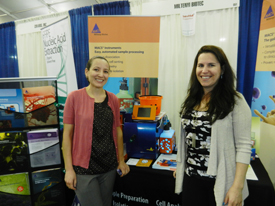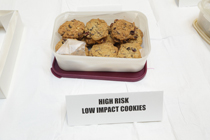Celebrating the Era of the Brain
Report from the 2014 NIH Research Festival
September 22, 2014: The government was open for business, unlike last year when the government shutdown forced the rescheduling of the NIH Research Festival from October to November. This year’s festival, celebrating “The Era of the Brain,” opened to a busy plenary session in Masur Auditorium (Building 10).

DANIEL REICH, NINDS
“The Era of the Brain” was the theme for the NIH 2014 Research Festival, which featured scientific presentations, poster sessions (including posters by scientific directors as well as institute directors), special exhibits, the vendor tent show, and more. Shown: A high-resolution magnetic-resonance imaging (MRI) scan of a person with multiple sclerosis (MS). The bright spots are MS plaques. The dark blobs are areas of iron deposition and the dark dots are veins.
It’s “that time during the year when we bring together all of the amazing talents that exist here in this intramural program,” said NIH Director Francis Collins, to “develop new ideas about science, about collaborations, about ways to make progress in [an] even more creative fashion.”
And with 19 concurrent symposia and more than 250 posters (not to mention the ever-popular directors’ poster session and cooking contest, the “Taste of Bethesda” lunch, and the Vendor Tent Show), the 2014 Festival was set to “showcase some good science,” said Festival Co-Chair Michael Krause, scientific director of the National Institute of Diabetes and Digestive and Kidney Diseases. “I think we did that!”
The festival celebrated and highlighted a newly energized focus on neuroscience in the NIH intramural and extramural programs alike. “This has been a great year for neuroscience on the NIH campus for bringing people together,” remarked Festival Co-Chair Catherine Bushnell, scientific director of the National Center for Complementary and Alternative Medicine (NCCAM). This year marks the start of the BRAIN (Brain Research through Advancing Innovative Neurotechnologies) initiative, a program meant to catalyze a fundamental understanding of the brain in health and disease through the development of novel technologies. Also during this year, the new Porter II Neuroscience building (Building 35) on the NIH campus opened, bringing together neuroscience researchers from many institutes.
The kickoff event for the Research Festival, the plenary session, included a presentation by Collins, an awards ceremony featuring the intramural Fellows Award for Research Excellence (FARE) program, and two presentations highlighting the neuroscience research done in the NIH intramural research program (IRP).

LAURA STEPHENSON CARTER
Two former postdocs were at the Vendor Tent Show, representing the company they work for now. Former FDA postdoc Cristina Nazarov (left) and former NCI postdoc Rima Adler (right) are technical sales consultants at MACS Miltenyi Biotec.
In his opening remarks, Collins discussed four key areas of the NIH intramural and extramural programs: basic research, data and technology, from basic science discoveries to routine medical use, and preparing the biomedical research workforce. For each area, Collins discussed key programs and initiatives within and beyond the NIH, starting with the BRAIN initiative. For the first year, Collins said, the NIH has dedicated $46 million to the initiative, meant to revolutionize our understanding of the human brain and foster the development of new technologies to explore “how the circuits of the brain do what they do.”
A partnership with NIH’s Big Data to Knowledge (BD2K) program will accelerate the development of quantitative measures to help answer neuroscience questions by harnessing the massive amounts of data being produced in areas such as genomics, imaging, and health records. In addition, the Accelerating Medicines Partnership, a program joining NIH with nonprofit organizations and biopharmaceutical companies, aims to foster the translation of research to therapeutics for key targets such as Alzheimer disease, systemic lupus erythematosus, and type 2 diabetes.
And finally, Collins highlighted the NIH’s effort to expand the diversity of the biomedical research workforce, particularly increasing the contribution of underrepresented groups and encouraging early-stage investigators. Bringing the conversation back to the intramural program, Collins talked about how pleased he was that the IRP had initiated a long-term planning effort to determine where it should be in 10 years.
“We don’t just want to rearrange things a little bit,” he said. “We want to think big [and] should be aiming high [for] this remarkable program.”
After the presentation of the FARE, Women’s Science Advisors (WSA) Scholars, and Virology Interest Group awards, Antonello Bonci, scientific director of the National Institute on Drug Abuse, offered the first scientific presentation of the festival, covering his research into dopamine receptors and their role in addiction.
“I met these dopamine receptors 25 years ago, and I still love them,” Bonci said. Addictive drugs can cause long-term changes in neuronal activity. Bonci uses optogenetics, a technique that combines light and genetically encoded light-sensitive proteins to control cell behavior. He found that cocaine abusers have a lower than normal neural activity in specific areas of the prefrontal cortex, an area of the brain that controls executive functions and decision-making. With optogenetics, one can directly modulate the addictive behaviors by activating these neurons.
“Having these methods and use of optogenetics can really inform you about all the fundamental information you need,” Bonci said. “We don’t need to wait 15 years to figure out the mechanism. [W]e can use this data to guide and inform clinicians.”
In the final presentation, Mark Hallett, a senior investigator in the National Institute of Neurological Disorders and Stroke, discussed his research on movement disorders. Hallett has led the field in using neurophysiological methods to understand the neurology and physiology of movement disorders. He described his work with focal hand dystonia, the most common forms of which are “musician’s cramp” and “writer’s cramp.” Dystonia is a movement disorder involving abnormal muscle contractions, repetitive movements, and/or posturing. In focal hand dystonia, the muscle contraction often occurs in a single hand during a specific task.
He set out to explore the neurological basis for the disorder, focusing on two areas: “overflow,” or the movement of undesired muscles as well as the desired muscles, and the task specificity of the condition. Using transcranial magnetic stimulation, a technique that allows for the stimulation of particular areas within the motor cortex, Hallett studied the role of “surround inhibition.” He found that, normally, when a subject wishes to perform a movement—such as playing the piano—the desired muscles are activated while the surrounding muscles are inhibited; however, in focal hand dystonia, this inhibition is impaired, leading to unintended muscle contraction. In the piano player’s cramp, some of the fingers may develop abnormal postures while piano playing but not with any other task. Using functional magnetic resonance imaging, Hallett found reduced brain activity in “overlearned” motor programs.
“We hope that the understanding of the physiology…will lead to better treatments for the patients,” he said.
Over the course of three days, similar stories of basic and translational research, and everything in-between, were shared through posters, concurrent symposia, and lots of scientific interactions.
“We get so caught up in our little worlds—not interfacing with the people in your own group, much less the people down the hall or in a different building,” said Krause. The NIH Research Festival “is a way to get people out and about, and see what’s out there!”
To see a videocast of the plenary session, go to http://videocast.nih.gov/launch.asp?18629. To read an article on Hallett’s work that appeared in the July-August issue of the NIH Catalyst, go to https://irp.nih.gov/catalyst/v22i4/human-motor-control.
Senior Scientists Show Off Their Posters…and Baked Goods

ERNIE BRANSON
Everyone’s getting into the act. NIDDK Scientific Director Michael Krause (right) explains his poster to colleagues at the 2014 Research Festival Poster Session. From left: Catherine Bushnell (NCCAM scientific director), Richard Wyatt (deputy director, Office of Intramural Research), and Darryl Zeldin (NIEHS scientific director). Krause and Bushnell were also co-chairs of the Research Festival.
Poster sessions at the NIH Research Festival are no longer the exclusive purview of the postdoctoral fellows. For the second year in a row, NIH’s scientific directors—and even a few institute directors—displayed posters at the festival and enthusiastically explained their research to anyone who would listen. And the directors gamely displayed their culinary expertise in a cooking contest, too.
While explaining the pharmacokinetic behavior of the ATP-binding cassette sub-family G member 2 (ABCG2) transporter in the blood–brain barrier (“Direct Bioluminescent Imaging of ABCG2 Function at the Blood–Brain Barrier using the Specific Substrate D-Luciferin”), Michael Gottesman recollected how a 1983 poster session influenced his career. He met a fellow poster presenter, someone from the Massachusetts Institute of Technology (Cambridge, Massachusetts) whose poster showed a novel technique isolating amplified gene fragments. The two collaborated, Gottesman adopted the technique in his research, his career took off, and he eventually became NIH’s Deputy Director for Intramural Research.
NCI Director Harold Varmus explained the roles of splicing-factor mutations in lung carcinomas and myeloid neoplasms (“Investigating the Roles of Splicing Factor Mutations in Lung Adenocarcinomas and Myeloid Nneoplasms”). His research group is trying to understand the functional impact of splice variants of U2 auxiliary factor 65-kDa subunit in the pathogenesis of cancer using transgenic mice carrying the mutant allele and isogenic human bronchial epithelial cells carrying the splicing mutants.
When science is not keeping them busy, the directors are not afraid to get their hands dirty—in the kitchen. Along with traditional chocolate-chip cookies, oatmeal cookies, and chocolate overload brownies, the budding chefs showcased the ethnic diversity of NIH’s scientific community by whipping up delicacies such as cannoli and biscotti, too.
Finally, the winners. “Who said pain doesn’t pay?” asked Gottesman as he announced the poster winner: NCCAM Scientific Director Catherine Bushnell for her poster on how chronic pain can have downstream effects on people beyond the pain itself (“Effect of Environment on the Long-Term Consequences of Chronic Pain”). Bushnell emphasized that pain may be reduced or prevented by making simple lifestyle changes such as practicing yoga or meditation.

NIGMS Director Jon Lorsch’s “high-risk, low-impact cookies” was one of two winning entries at the Research Festival’s cooking contest.
Judging the directors’ culinary expertise was no easy task with so many delicious desserts to choose from. So the judges decided to declare two winners: NIGMS Director Jon Lorsch for his “high-risk low-impact cookies” and NIA Scientific Director Luigi Ferrucci for his biscotti di Prato (a cookie from his hometown in Italy).
To read descriptions of all the 2014 Research Festival posters, go to http://researchfestival.nih.gov/2014/posters.cgi. The scientific directors and institute directors posters are in Poster Session II
This page was last updated on Saturday, January 18, 2025
